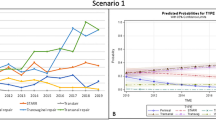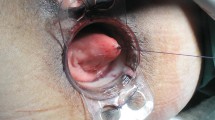Abstract
Background
In obstructive defecation syndrome (ODS) combinations of morphologic alterations of the pelvic floor and the colorectum are nearly always evident. Laparoscopic resection rectopexy (LRR) aims at restoring physiological function. We present the results of 19 years of experience with this procedure in patients with ODS.
Methods
Between 1993 and 2012, 264 patients underwent LRR for ODS at our department. Perioperative and follow-up data were analyzed.
Results
The female/male ratio was 25.4:1, mean age was 61.3 years (±14.3 years), and mean body mass index (BMI) was 25.2 kg/m2 (±4.2 kg/m2). The pathological conditions most frequently found in combination were a sigmoidocele plus a rectocele (n = 79) and a sigmoidocele plus a rectal prolapse or intussusception (n = 69). The conversion rate was 2.3 % (n = 6). The mortality rate was 0.75 % (n = 2), the rate of complications requiring surgical re-intervention was 4.3 % (n = 11), and the rate of minor complications was 19.8 % (n = 51). Follow-up data were available for 161 patients with a mean follow-up of 58.2 months (±47.1 months). Long-term results showed that 79.5 % of patients (n = 128) reported at least an improvement of symptoms. In cases of a sigmoidocele (n = 63 available for follow-up) or a rectal prolapse II°/III° (n = 72 available for follow-up), the improvement rates were 79.4 % (n = 50) and 81.9 % (n = 59), respectively.
Conclusions
LRR is a safe and effective procedure. Our perioperative results and long-term functional outcome strengthen the evidence regarding benefits of LRR in patients with an outlet obstruction. However, careful patient selection is essential.


Similar content being viewed by others
References
Suares NC, Ford AC (2011) Prevalence of, and risk factors for, chronic idiopathic constipation in the community: systematic review and meta-analysis. Am J Gastroenterol 106:1582–1591
Sonnenberg A, Koch TR (1989) Epidemiology of constipation in the United States. Dis Colon Rectum 32:1–8
Longstreth GF, Thompson WG, Chey WD, Houghton LA, Mearin F, Spiller RC (2006) Functional bowel disorders. Gastroenterology 130:1480–1491
Schiedeck TH, Schwandner O, Scheele J, Farke S, Bruch HP (2005) Rectal prolapse: which surgical option is appropriate? Langenbecks Arch Surg 390:8–14
Ommer A, Rolfs T, Walz MK (2010) Chirurgische Therapieoptionen bie Stuhlentleerungsstörungen. CHAZ 11:393–404
Lehur PA, Stuto A, Fantoli M et al (2008) Outcomes of stapled transanal rectal resection vs. biofeedback for the treatment of outlet obstruction associated with rectal intussusception and rectocele: a multicenter, randomized, controlled trial. Dis Colon Rectum 5:1611–1618
Gervaz P, Inan I, Perneger T, Schiffer E, Morel P (2010) A prospective, randomized, single-blind comparison of laparoscopic versus open sigmoid colectomy for diverticulitis. Ann Surg 252:3–8
Samaranayake CB, Luo C, Plank AW, Merrie AE, Plank LD, Bissett IP (2010) Systematic review on ventral rectopexy for rectal prolapse and intussusception. Colorectal Dis 12:504–512
Tou S, Brown SR, Malik AI, Nelson RL (2008) Surgery for complete rectal prolapse in adults. Cochrane Database Syst Rev (4):CD001758. doi:10.1002/14651858.CD001758.pub2
Madiba TE, Baig MK, Wexner SD (2005) Surgical management of rectal prolapse. Arch Surg 140:63–73
Matzel KE, Heuer S, Zhang W (2008) Rectal prolapse. Abdominal or local approach. Chirurg 79:444–451
Laubert T, Bader FG, Kleemann M et al. (2012) Outcome analysis of elderly patients undergoing laparoscopic resection rectopexy for rectal prolapse. Int J Colorectal Dis. doi:10.1007/s00384-011-1395-1
Ng SS, Leung KL, Lee JF, Yiu RY, Li JC, Hon SS (2009) Long-term morbidity and oncologic outcomes of laparoscopic-assisted anterior resection for upper rectal cancer: ten-year results of a prospective, randomized trial. Dis Colon Rectum 52:558–566
Ashari LH, Lumley JW, Stevenson AR, Stitz RW (2005) Laparoscopically-assisted resection rectopexy for rectal prolapse: ten years’ experience. Dis Colon Rectum 48:982–987
Johnson E, Stangeland A, Johannessen HO, Carlsen E (2007) Resection rectopexy for external rectal prolapse reduces constipation and anal incontinence. Scand J Surg 96:56–61
von Papen M, Ashari LH, Lumley JW, Stevenson AR, Stitz RW (2007) Functional results of laparoscopic resection rectopexy for symptomatic rectal intussusception. Dis Colon Rectum 50:50–55
Kariv Y, Delaney CP, Casillas S et al (2006) Long-term outcome after laparoscopic and open surgery for rectal prolapse: a case-control study. Surg Endosc 20:35–42
Jorge JM, Yang YK, Wexner SD (1994) Incidence and clinical significance of sigmoidoceles as determined by a new classification system. Dis Colon Rectum 37:1112–1117
Bruch HP, Herold A, Schiedeck T, Schwandner O (1999) Laparoscopic surgery for rectal prolapse and outlet obstruction. Dis Colon Rectum 42:1189–1194
Laubert T, Kleemann M, Schorcht A et al (2010) Laparoscopic resection rectopexy for rectal prolapse: a single-center study during 16 years. Surg Endosc 24:2401–2406
Roblick UJ, Bader FG, Jungbluth T, Laubert T, Bruch HP (2011) How to do it-laparoscopic resection rectopexy. Langenbecks Arch Surg 396:851–855
Pescatori M, Spyrou M, Pulvirenti d’Urso A (2006) A prospective evaluation of occult disorders in obstructed defecation using the ‘iceberg diagram’. Colorectal Dis 8:785–789
Bruch H-P, Fischer F, Schiedeck TH, Schwandner O (2004) Defäkationsobstruktion. Chirurg 75:861–870
Schwandner O, Farke S, Fischer F, Schiedeck TH, Bruch HP (2004) Chirurgische Therapie der Outlet-Obstrudkion bei Sigmoidozelen - Ist die lapaorskopische Operation sicher und komplikationsarm? Coloproctology 26:75–84
Thompson JR, Chen AH, Pettit PD, Bridges MD (2002) Incidence of occult rectal prolapse in patients with clinical rectoceles and defecatory dysfunction. Am J Obstet Gynecol 187:1494–1499
Dodi G, Pietroletti R, Milito G, Binda G, Pescatori M (2003) Bleeding, incontinence, pain and constipation after STARR transanal double stapling rectotomy for obstructed defecation. Tech Coloproctol 7:148–153
Boccasanta P, Venturi M, Stuto A et al (2004) Stapled transanal rectal resection for outlet obstruction: a prospective, multicenter trial. Dis Colon Rectum 47:1285–1296
Madbouly KM, Abbas KS, Hussein AM (2010) Disappointing long-term outcomes after stapled transanal rectal resection for obstructed defecation. World J Surg 34:2191–2196
Zbar AP, Lienemann A, Fritsch H, Beer-Gabel M, Pescatori M (2003) Rectocele: pathogenesis and surgical management. Int J Colorectal Dis 18:369–384
Vermeulen J, Lange JF, Sikkenk AC, van der Harst E (2005) Anterolateral rectopexy for correction of rectoceles leads to good anatomical but poor functional results. Tech Coloproctol 9:35–41
Kim M, Reibetanz J, Boenicke L, Germer CT, Jayne D, Isbert C (2012) Quality of life after laparoscopic resection rectopexy. Int J Colorectal Dis 27:489–495
Orrom WJ, Bartolo DC, Miller R, Mortensen NJ, Roe AM (1991) Rectopexy is an ineffective treatment for obstructed defecation. Dis Colon Rectum 34:41–46
D’Hoore A, Vanbeckevoort D, Penninckx F (2008) Clinical, physiological and radiological assessment of rectovaginal septum reinforcement with mesh for complex rectocele. Br J Surg 95:1264–1272
Oom DM, Gosselink MP, van Wijk JJ, van Dijl VR, Schouten WR (2008) Rectocele repair by anterolateral rectopexy: long-term functional outcome. Colorectal Dis 10:925–930
Schultz I, Mellgren A, Dolk A, Johansson C, Holmstrom B (2000) Long-term results and functional outcome after Ripstein rectopexy. Dis Colon Rectum 43:35–43
Marchal F, Bresler L, Ayav A et al (2005) Long-term results of Delorme’s procedure and Orr-Loygue rectopexy to treat complete rectal prolapse. Dis Colon Rectum 48:1785–1790
Portier G, Iovino F, Lazorthes F (2006) Surgery for rectal prolapse: Orr-Loygue ventral rectopexy with limited dissection prevents postoperative-induced constipation without increasing recurrence. Dis Colon Rectum 49:1136–1140
Gemsenjager E (1996) Internal rectal prolapse: therapy outcome and current status. Schweiz Med Wochenschr German 126:1377–1384
Kellokumpu IH, Vironen J, Scheinin T (2000) Laparoscopic repair of rectal prolapse: a prospective study evaluating surgical outcome and changes in symptoms and bowel function. Surg Endosc 14:634–640
Tsiaoussis J, Chrysos E, Athanasakis E et al (2005) Rectoanal intussusception: presentation of the disorder and late results of resection rectopexy. Dis Colon Rectum 48:838–844
Benoist S, Taffinder N, Gould S, Chang A, Darzi A (2001) Functional results two years after laparoscopic rectopexy. Am J Surg 182:168–173
Vignali A, Di Palo S, Tamburini A, Radaelli G, Orsenigo E, Staudacher C (2005) Laparoscopic vs. open colectomies in octogenarians: a case-matched control study. Dis Colon Rectum 48:2070–2075
Acknowledgments
Mrs. C. Killaitis is gratefully acknowledged for keeping the database updated and for performing the statistical calculations.
Conflict of interest
None.
Author information
Authors and Affiliations
Corresponding author
Rights and permissions
About this article
Cite this article
Laubert, T., Kleemann, M., Roblick, U.J. et al. Obstructive defecation syndrome: 19 years of experience with laparoscopic resection rectopexy. Tech Coloproctol 17, 307–314 (2013). https://doi.org/10.1007/s10151-012-0925-3
Received:
Accepted:
Published:
Issue Date:
DOI: https://doi.org/10.1007/s10151-012-0925-3




